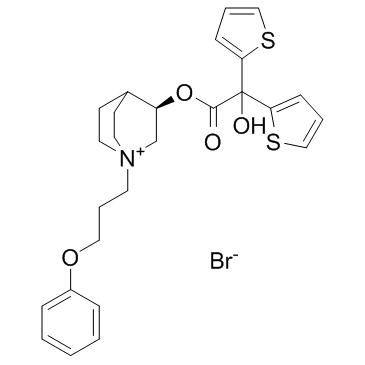320345-99-1
| Name | aclidinium bromide |
|---|---|
| Synonyms |
[(3R)-1-(3-phenoxypropyl)-1-azoniabicyclo[2.2.2]octan-3-yl] 2-hydroxy-2,2-dithiophen-2-ylacetate,bromide
UNII-UQW7UF9N91 1-Azoniabicyclo[2.2.2]octane, 3-[(2-hydroxy-2,2-di-2-thienylacetyl)oxy]-1-(3-phenoxypropyl)-, bromide, (3R)- (1:1) Tudorza Pressair LAS W-330 (3R)-3-[2-Hydroxy(di-2-thienyl)acetoxy]-1-(3-phenoxypropyl)-1-azoniabicyclo[2.2.2]octane bromide Eklira Bretaris Aclidinium bromide (3R)-3-(2-Hydroxy-2,2-di(thiophen-2-yl)acetoxy)-1-(3-phenoxypropyl)quinuclidin-1-ium bromide Aclidinium (Bromide) |
| Description | Aclidinium Bromide(LAS 34273; LAS-W 330) is a long-acting, inhaled muscarinic antagonist as a maintenance treatment for chronic obstructive pulmonary disease (COPD). IC50 value:Target: M3 receptorPreclinically, aclidinium showed potent antagonism of human muscarinic receptors, with a long residence time at M3 receptors and a shorter residence time at M2 receptors, indicating the potential to provide sustained bronchodilation. Aclidinium is rapidly hydrolysed in human plasma, unlike other currently available antimuscarinics including tiotropium. Early clinical studies in healthy subjects have confirmed the low systemic bioavailability and favourable safety profile of single and multiple doses of aclidinium. In a subsequent Phase IIb study, which included 464 patients with moderate to severe COPD, aclidinium displayed long-lasting bronchodilatory activity and was well tolerated. |
|---|---|
| Related Catalog | |
| References |
| Molecular Formula | C26H30BrNO4S2 |
|---|---|
| Molecular Weight | 564.555 |
| Exact Mass | 563.079956 |
| PSA | 112.24000 |
| LogP | 1.62960 |
